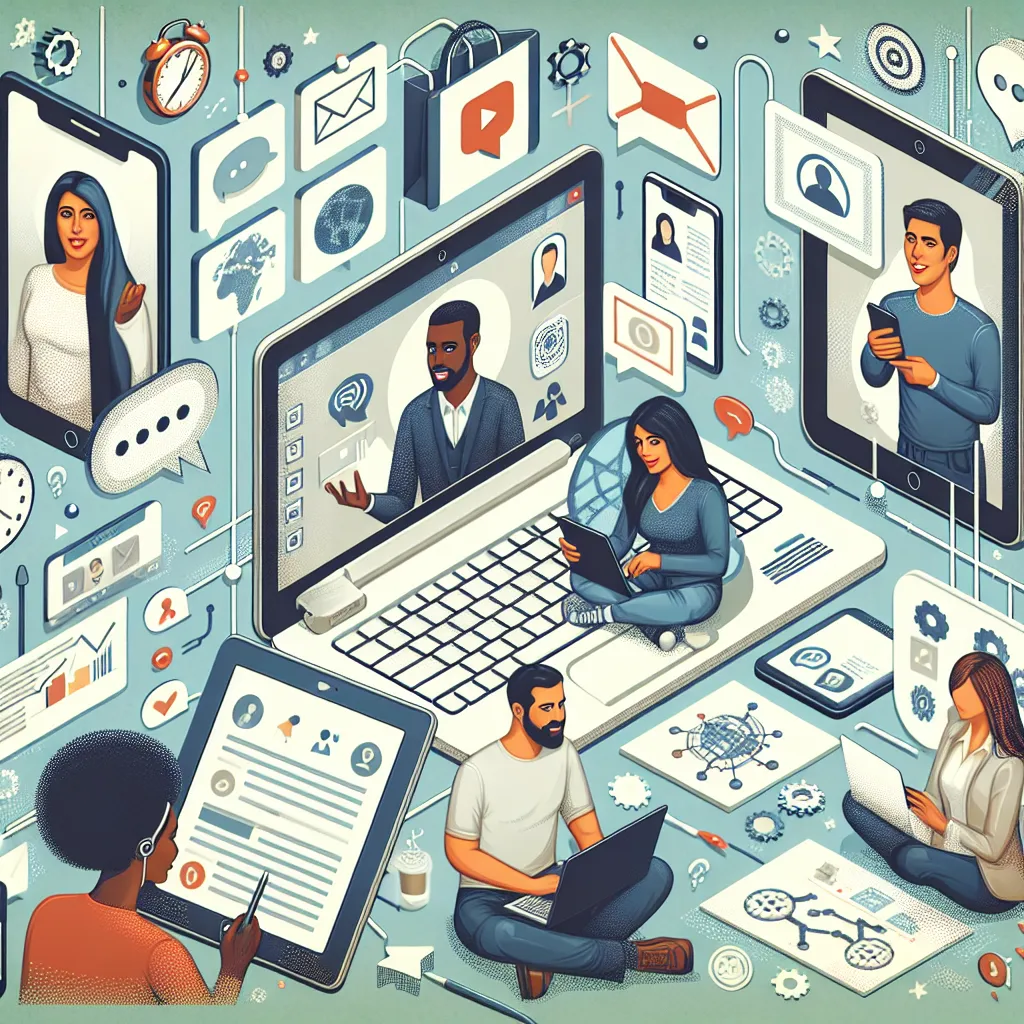In recent years, the topic of adapting to new online communication tools has become increasingly prevalent in IELTS Speaking tests. As our world becomes more digitally connected, examiners are keen to assess candidates’ ability to discuss technological changes and their personal experiences with online communication. This article will provide you with valuable insights and strategies to excel in this topic during your IELTS Speaking test.
Nội dung bài viết
- Part 1: Introduction and Interview
- Q: How often do you use online communication tools?
- Q: What are the advantages of using online communication tools?
- Part 2: Long Turn
- Follow-up Questions:
- Part 3: Two-way Discussion
- Q: How do you think online communication tools have changed the way people work?
- Q: What are some potential drawbacks of relying too heavily on online communication?
- Key Vocabulary and Phrases for High Scores
- Examiner’s Advice
 Digital Communication Tools
Digital Communication Tools
Part 1: Introduction and Interview
In this section, the examiner may ask you some general questions about online communication. Here are some possible questions and sample answers:
Q: How often do you use online communication tools?
Band 6-7 Answer:
I use online communication tools quite frequently, probably every day. I mainly use messaging apps to stay in touch with friends and family, and sometimes I use video calls for work meetings.
Band 8-9 Answer:
I’d say I’m constantly engaged with various online communication tools throughout my day. From collaborating with colleagues on project management platforms to maintaining personal connections through social media and video calls, these tools have become an integral part of both my professional and personal life.
Q: What are the advantages of using online communication tools?
Band 6-7 Answer:
Online communication tools are very convenient. They allow us to talk to people anywhere in the world instantly, which saves time and money. They also make it easier to share information and files quickly.
Band 8-9 Answer:
The advantages of online communication tools are manifold. Firstly, they bridge geographical gaps, enabling real-time collaboration regardless of physical location. Additionally, they offer unprecedented flexibility, allowing us to tailor our communication style to different contexts. Moreover, these tools often integrate multiple functionalities, such as file sharing and screen sharing, which significantly enhance productivity and efficiency in both professional and personal spheres.
Part 2: Long Turn
Now, let’s look at a possible cue card related to this topic:
You should say:
- What the new online communication tool was
- When and why you had to start using it
- How you learned to use it
- And explain how it affected your communication
Band 6-7 Answer:
I’d like to talk about when I had to start using Zoom for online classes during the pandemic. It was in early 2020 when our university suddenly shifted to online learning. I had to use Zoom because it was the platform chosen by our school for virtual lectures and seminars.
Learning to use Zoom was a bit challenging at first. I watched some tutorial videos online and practiced with friends before my first class. It took some time to get used to features like screen sharing and breakout rooms.
Using Zoom definitely changed how I communicated in class. It was different from face-to-face interactions, but it allowed us to continue our education despite the lockdown. I had to learn to speak more clearly and use the chat function effectively.
Overall, adapting to Zoom was necessary and beneficial, even though it had its challenges.
Band 8-9 Answer:
I’d like to recount my experience of adapting to Microsoft Teams, a comprehensive collaboration platform, which I had to swiftly integrate into my work routine when our company transitioned to remote operations due to the global pandemic in March 2020.
The imperative to adopt this tool stemmed from our organization’s need for a unified communication system that could seamlessly incorporate various aspects of our work, from video conferencing to document sharing and project management.
My journey to mastering Teams was quite intensive. I immersed myself in online tutorials, attended webinars hosted by Microsoft, and actively participated in mock meetings with colleagues to familiarize myself with its myriad features. What significantly accelerated my learning curve was the peer support system we established, where team members would share tips and troubleshoot issues collectively.
The impact of Teams on my communication was profound and multifaceted. It revolutionized our team dynamics by providing a centralized hub for all project-related discussions and resources. The ability to instantaneously switch between chat, video calls, and collaborative document editing markedly enhanced our productivity. Moreover, it fostered a more inclusive environment, as features like real-time translation and screen reader compatibility made communication more accessible to all team members.
In retrospect, while the initial adaptation period was challenging, embracing Microsoft Teams proved to be a catalyst for improving our team’s communication efficiency and cohesion, ultimately propelling us towards a more agile and digitally adept work culture.
Follow-up Questions:
- How did this experience change your view on technology in communication?
Band 6-7 Answer:
This experience made me realize how important technology is for communication, especially in unexpected situations like a pandemic. It showed me that we can adapt to new ways of communicating when necessary.
Band 8-9 Answer:
This experience was truly eye-opening and transformative in terms of my perspective on technology in communication. It underscored the pivotal role that technological advancements play in ensuring continuity and adaptability in our increasingly unpredictable world. Moreover, it heightened my appreciation for the rapid pace of innovation in communication technologies and their potential to revolutionize traditional paradigms of interaction and collaboration.
- Do you think online communication tools will replace face-to-face communication in the future?
Band 6-7 Answer:
I don’t think online tools will completely replace face-to-face communication. While they’re very useful, especially for long-distance communication, in-person interactions are still important for building relationships and understanding each other better.
Band 8-9 Answer:
While online communication tools have undoubtedly transformed the landscape of human interaction, I believe it’s unlikely they will entirely supplant face-to-face communication. These digital platforms certainly offer unparalleled convenience and have expanded our communicative horizons. However, the nuanced aspects of in-person interaction – such as non-verbal cues, spontaneous exchanges, and the intangible energy of physical presence – remain irreplaceable in many contexts. I envision a future where digital and physical modes of communication coexist symbiotically, each leveraged for its unique strengths to create a more holistic and enriching communicative ecosystem.
Part 3: Two-way Discussion
In this section, the examiner will ask more abstract questions related to the topic. Here are some possible questions and sample answers:
Q: How do you think online communication tools have changed the way people work?
Band 6-7 Answer:
Online communication tools have made work more flexible. People can now work from home or anywhere in the world. These tools have also made it easier to collaborate with colleagues in different locations. However, they’ve also blurred the line between work and personal life, which can be challenging for some people.
Band 8-9 Answer:
The advent of online communication tools has precipitated a paradigm shift in the modern workplace. These technologies have dismantled geographical barriers, fostering a global talent pool and enabling round-the-clock productivity across time zones. They’ve also catalyzed the rise of remote and hybrid work models, offering unprecedented flexibility and potentially improving work-life balance for many.
However, this digital transformation is not without its complexities. While enhancing connectivity, these tools have also blurred the boundaries between professional and personal spheres, potentially leading to always-on culture and burnout. Moreover, they’ve necessitated a recalibration of management strategies to maintain team cohesion and company culture in virtual environments.
Ultimately, online communication tools have revolutionized work dynamics, demanding new skills like digital literacy and virtual collaboration, while also opening up exciting possibilities for innovation and global cooperation.
Q: What are some potential drawbacks of relying too heavily on online communication?
Band 6-7 Answer:
Relying too much on online communication can lead to a lack of personal connection. It’s harder to build strong relationships when you’re not meeting in person. There’s also the risk of misunderstandings because you can’t see body language or hear tone of voice in text messages. Additionally, spending too much time online can be tiring and affect mental health.
Band 8-9 Answer:
While online communication tools offer numerous benefits, an over-reliance on these platforms can engender several significant drawbacks. Firstly, it can lead to a deterioration of interpersonal skills and emotional intelligence, as the nuances of face-to-face interaction are often lost in digital translation. This can result in miscommunication and erosion of empathy in both personal and professional relationships.
Secondly, the constant connectivity facilitated by these tools can contribute to information overload and digital fatigue, potentially impacting mental health and work-life balance. The pressure to be perpetually available can lead to stress and burnout.
Moreover, an excessive dependence on online communication may exacerbate existing social inequalities, as access to technology and digital literacy are not uniformly distributed across societies. This digital divide could potentially marginalize certain groups and hinder their participation in increasingly online-centric social and professional spheres.
Lastly, there are valid concerns about data privacy and cybersecurity. As more of our interactions move online, we become more vulnerable to data breaches and unauthorized surveillance, which could have far-reaching implications for personal and national security.
Key Vocabulary and Phrases for High Scores
-
Adapt (verb) /əˈdæpt/ – to change, or to change something, to suit different conditions or uses
Example: We had to adapt quickly to the new online learning environment. -
Integrate (verb) /ˈɪntɪɡreɪt/ – to combine two or more things in order to become more effective
Example: The company integrated various communication tools into one platform. -
Paradigm shift (noun) /ˈpærədaɪm ʃɪft/ – a major change in the concepts and practices of how something works or is accomplished
Example: The move to remote work represented a paradigm shift in how businesses operate. -
Revolutionize (verb) /ˌrevəˈluːʃənaɪz/ – to change something completely and dramatically
Example: Video conferencing has revolutionized the way we conduct international business meetings. -
Catalyst (noun) /ˈkætəlɪst/ – something that causes an important event to happen
Example: The pandemic acted as a catalyst for the rapid adoption of digital communication tools.
Examiner’s Advice
To achieve a high score in the IELTS Speaking test when discussing adapting to new online communication tools:
-
Develop a rich vocabulary related to technology and communication. Use precise terms and idiomatic expressions where appropriate.
-
Structure your answers logically, using discourse markers to guide the listener through your thoughts.
-
Provide specific examples from your personal experience to illustrate your points.
-
Demonstrate critical thinking by discussing both advantages and potential drawbacks of online communication tools.
-
Practice speaking fluently about technology-related topics, focusing on clear pronunciation and natural intonation.
Remember, the key to success in IELTS Speaking is not just about what you say, but how you say it. Confidence, fluency, and the ability to express complex ideas clearly are all crucial factors in achieving a high band score.
For more tips on improving your IELTS Speaking skills, you might find our article on describing a time when you had to navigate a cultural difference online helpful. Additionally, our guide on describing a time when you participated in a virtual team building activity offers valuable insights into discussing online collaboration effectively.


